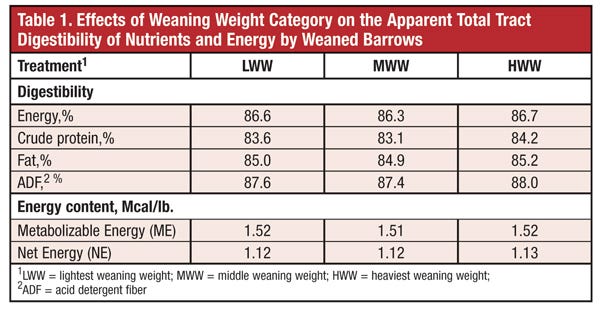Getting to the Root Of Fallback Pigs
The last decade’s unprecedented rise in litter size has resulted in more pigs that fail to achieve performance equal to their contemporaries. These pigs are commonly referred to as “fallback pigs.”
December 15, 2012

The last decade’s unprecedented rise in litter size has resulted in more pigs that fail to achieve performance equal to their contemporaries. These pigs are commonly referred to as “fallback pigs.”
Fallback pigs may be lighter at birth, but normal and heavy birth weight pigs can also become fallback pigs due to poor nutrition, environmental conditions, disease or other unknown reasons. Whatever the cause, these pigs compromise barn throughput, result in weight penalties at marketing and may reduce barn flow.
A better understanding of the factors contributing to fallback pigs may allow producers to develop environmental or nutritional interventions that would minimize their prevalence and thereby maximize production efficiency, throughput and profitability.
The overall objective of this study was to develop an understanding of the underlying biology of the fallback pig. Specific objectives included: 1) identify differences in the biology and physiology, thus the growth and metabolism between fallback pigs and their heavier, faster-growing counterparts; 2) determine if these differences result from variations in small intestine structure or function; and
3) determine the role of blood chemistry and immune status in fallback pigs vs. pigs with normal performance.
To accomplish these objectives, 120 weanling pigs were utilized in growth, metabolism and comparative slaughter experiments. Forty barrows from each of the lightest, median and heaviest 10% of pigs at weaning were placed in individual crates with slotted floors to allow for fecal and urine collection.
Eight pigs from each category were harvested on Day 5, postweaning, as the initial slaughter group (Table 1). These data show that irrespective of weaning weight, pigs digested energy, nitrogen, fat, fiber and ash equally, and that the determined energy value of the diets fed to the pigs also was not affected by weaning weight.

The remaining 32 pigs in each category made up the metabolism group and were utilized in a growth and metabolism experiment, then were slaughtered.
After the live animal component of the experiment was complete, pigs within each initial weight category were further stratified into the slowest, median, and fastest average daily gain (ADG) categories — 33% in each — which resulted in a total of nine treatments. Fallback pigs were designated as those belonging to the slowest ADG category from either the lightest or median weight categories.
In contrast to the initial hypothesis, there was no effect of treatment on feed efficiency, which suggests that improvements in ADG were primarily driven by average daily feed intake (ADFI).
Kidney and intestine weights, as well as protein and fat deposition rates, were affected by weight and ADG category, even when equalized per unit of body weight. These variations confirm that fallback pigs differ in both their biology and physiology compared to their heavier, faster-growing contemporaries.
In order to further understand why these differences in carcass composition occur, the digestibility of nutrients and efficiency of energy utilization were measured and found to be maximized by pigs in the median ADG categories. While it may be more intuitive for these to be maximized by the fastest ADG categories, experiments by other researchers largely agree with these findings.
Additionally, bicarbonate levels in the blood were highest in the two extreme categories — the slowest ADG, lightest weight category and the fastest ADG, heaviest weight category. Bicarbonate is a measure of acid-base balance and the variation in its measurement is further evidence that both the poorest- and the highest-performing pigs may have poorer physiological regulation compared to their contemporaries. These differences in nutrient digestibility, energy utilization and blood metabolites underscore the importance of managing the entire variation of a population, not just the poorest performers.
There were no distinct patterns in differences in small intestine structure or function, nor were white blood cell or lymphocyte concentrations affected by fallback status. Thus, all pigs in the experiment, even fallback pigs, appeared to have had similar health status.
Taken together, these results suggest that the underlying cause for fallback from performance lies jointly with poor feed intake and poorer utilization of absorbed nutrients. There is still little explanation as to the root cause of poorer nutrient utilization.
In this experiment, we have characterized the biological and physiological differences in fallback pigs and identified the underlying causes for fallback from performance.
While this experiment has made strides toward identifying management strategies that are more calculated and economical, the next phase of research must be undertaken in a commercial environment. We are currently collaborating with veterinary pathologists, an Iowa pork producer and the Iowa Pork Producers Association to evaluate the broader factors affecting fallback from performance in a commercial setting.
Researchers: John Patience and Cassie Jones, Iowa State University, Ames, IA. Contact Patience by phone (515) 294-5132 or e-mail [email protected].
You May Also Like



